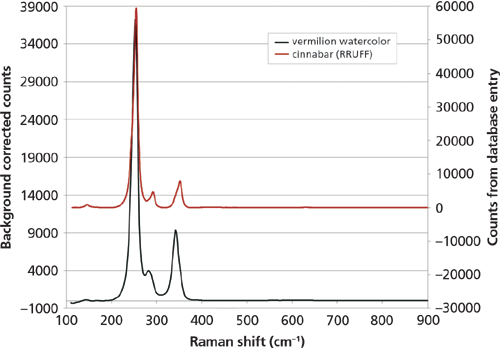Raman Spectroscopy for Pigment Identification
Raman spectroscopy is well-recognized in the art conservation and archaeology fields for the identification of pigments. This application note is a preview of a more extensive document detailing the use of TSI |ChemLogix instruments in-situ of fresco artworks and fresco materials in the lab.
Raman spectroscopy is a valuable tool in the arsenal of the art conservationist. Through the acquisition of a vibrational spectrum of the surface of a sample, various information is gleaned: the type of material (inorganic or organic) present in the pigment and what weathering or environmental damage has occurred, for example. Additionally, this information helps to establish authenticity and provenance of paint and pigment substances. Several TSI instruments are currently being used in this field for these purposes. We are interested in helping to develop more effective measurement methods for the other challenging pigments that are encountered in older artifacts, especially those with green and blue-green mineral pigments, which have been found in the past to have a forbidding amount of native fluorescence.
Experimental Conditions
The Raman measurements discussed in this note were made with a TSI | Chemlogix ProRaman-L instrument with 20 mW of 785 nm laser excitation and a spectral range of 100–3300 cm-1. The spectra were collected with a 12-s acquisition period and 10x averaging. Room lights were excluded from the analysis by means of black plasticized cloth. The raw spectra were corrected for the native fluorescence in the material with the TSI standard background correction algorithm.
Results
The background-corrected Raman spectrum of a pan of vermilion water color pigment from natural pigments is shown in Figure 1 (1). It is plotted together with a Raman spectrum of cinnabar (HgS) from the RRUFFs database (University of Arizona and the California Institute of Technology) (2). Vermilion is a reddish pigment derived from crushed cinnabar (HgS) that was used as a red pigment by the ancients. In China, as early as the 4th century BC, a synthesis was developed using elemental mercury and sulfur. Due to its toxicity, vermilion has been almost completely replaced by cadmium red, starting in the 20th century. It is clear from the spectra in Figure 1 that the vermilion watercolor pan is the same material as the mineral reference, cinnabar. It is clear that this type of pigment identification can be used both to date paintings and discover frauds.

Figure 1: Background-corrected Raman spectra of vermilion pigment and the mineral cinnabar.
Conclusions
This brief application note discusses the value of Raman spectroscopy in the pursuit of pigment identification in the fields of art history and conservation. In the near future, more of this work, including the analysis of difficult green pigments, will be published.
References
(2) R.T. Downs, "The RRUFF Project: an integrated study of the chemistry, crystallography, Raman and infrared spectroscopy of minerals," paper presented at the 19th General Meeting of the International Mineralogical Association in Kobe, Japan. O03-13 (2006).

TSI, Incorporated
500 Cardigan Road, Shoreview, MN 55126
tel. (800) 874-2811, fax (651) 765-3725
Website: www.tsi.com
